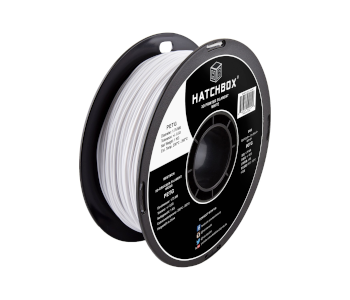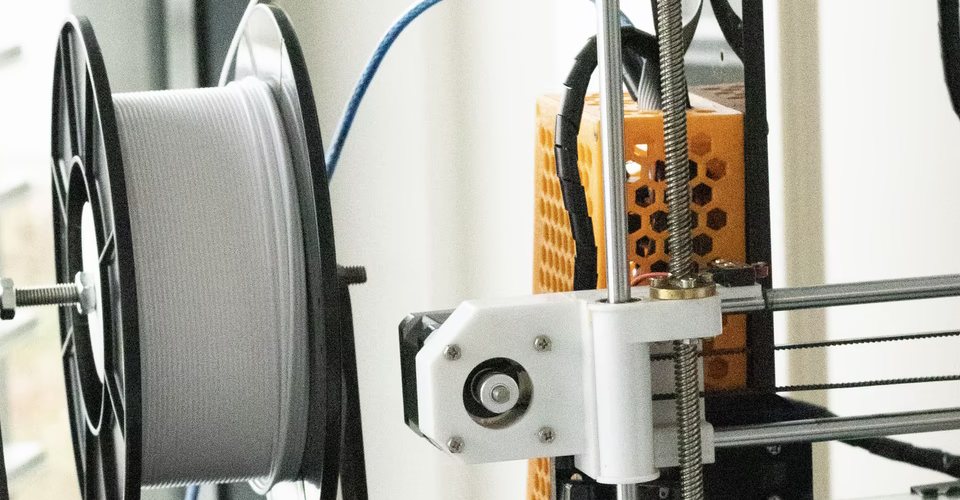What Is the Melting Point of PETG?
PETG melts at about 260 °C, although it starts transitioning to a more fluid-like state at 230 °C. If you’re designing parts to be 3D printed with PETG, you also need to take note of the material’s glass transition temperature at about 85 °C. This makes PETG more heat-stable than PLA but not quite at the level of ABS or Nylon.
PETG is considered by many as a filament that combines high-performance characteristics and ease of use. To make the most out of PETG, let us take a closer look at how the material reacts to increasing temperature.
The mechanism of PETG melting

PETG has often been described as the filament that combines the best features of the two most popular filaments in 3D printing, PLA and ABS. The molecular structure of PETG makes gives it chemical stability and thermal stability that is superior to PLA. However, it does not emit fumes and is not prone to warping – two things that make ABS difficult to work with.
However, PETG is also similar to PLA and ABS in that it is still a thermoplastic. This means that PETG can be melted and re-solidified without losing any of its essential characteristics. How does this mechanism work at a molecular level?
The key element of thermoplastics is that their intramolecular bonds do not become severed upon exposure to heat. This is true only up to a certain point but remains valid even at the material’s melting temperature. Upon reaching the melting temperature, the bonds of PETG stretch and become more flexible. Accordingly, the material can be molded to any shape.
In 3D printing, the flexibility that PETG gains is enough to allow it to be extruded through a narrow nozzle. As PETG cools down, the bonds become shorter again, resulting in the material becoming more rigid. This process can theoretically be repeated infinitely, but some material degradation can be observed with repeated melting cycles.
The relevance of glass transition temperature
We know by now that PETG needs to be heated to its melting temperature so that it can get soft enough to be extruded. However, it is equally important to know the glass transition temperature of PETG.
The glass transition temperature is the temperature at which the material enters the state between being solid and liquid. It is not completely fluid-like but can more easily deform when subjected to any stress. Beyond the glass transition temperature, an object made of PETG severely loses its mechanical strength.
PETG has a glass transition temperature of 85 °C. This is something you will need to consider when 3D printing anything with PETG. If your intended application involves temperatures higher than 85 °C, then you will be much better off using more heat-stable filaments like Nylon or Polycarbonate.
In the actual 3D printing process, the glass transition temperature is also useful as the benchmark for the temperature of a heated bed. PETG does not necessarily need to be printed with a heated bed but can still benefit from it. A heated bed is a huge help in bed adhesion and makes warping or deformation less likely.
You will want your heated bed to be just below the glass transition temperature of the filament. For PETG, the recommended temperature range is 70 to 80 °C. Heating the bed beyond 80 °C puts it too close to the glass transition temperature of PETG and risks deforming the first layer.
PETG compared to other 3D printing filaments

PETG has gained a lot of popularity in the last couple of years and can probably be considered one of the most widely used filaments in 3D printing. It offers a unique combination of ease of use and superior strength and stability.
In terms of ease of use, PETG is considered almost equal or just a notch below PLA. PETG does not emit unpleasant fumes, does not require a printed bed, and is not highly prone to warping. However, the performance characteristics of PETG – such as strength, chemical stability, and thermal stability – are closer to ABS than PLA.
In terms of the melting temperature, PETG is clearly superior to PLA. Compared to the onset of melting of PETG at 230 °C, PLA starts to melt at only 180 °C. This makes PETG much more appropriate for outdoor or high-temperature applications.
The melting point of PETG is just about equivalent to that of ABS. If you need to 3D print something with better heat stability, your best options would be either Nylon (260 to 270 °C), Polycarbonate (230 to 260 °C), Amphora (250 to 270 °C), or PEEK/PEI (360 to 400 °C).
Just take note that you will be dealing with more complicated warping issues when your print at higher temperatures. For instance, printing with PEEK/PEI often involves actively heating a heavily insulated print chamber just to avoid warping.
Final thoughts
The unique combination of benefits that PETG offers has made it an extremely popular filament in the 3D printing. PETG is the go-to filament when you’re planning to 3D print something with good thermal stability, but you can’t be bothered to deal with so many warping issues.
The melting point of PETG is significantly higher than PLA and is approximately the same as that of ABS. There are several other 3D printing filaments that exhibit better heat stability, such as Polycarbonate of PEEK/PEI. However, these also considerably harder to work with.


